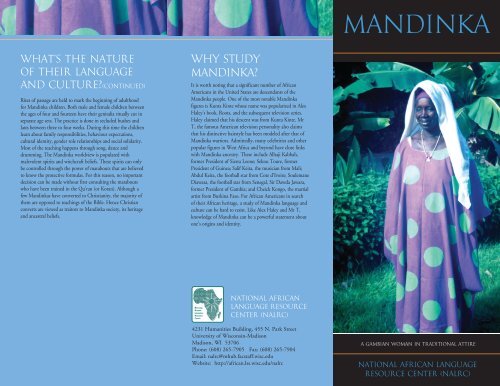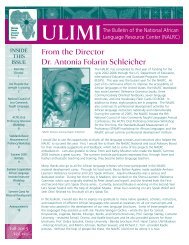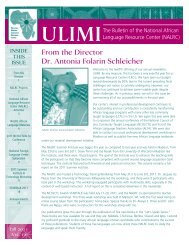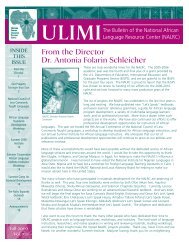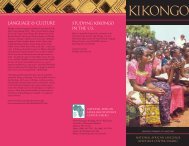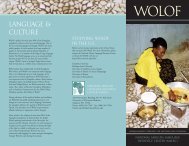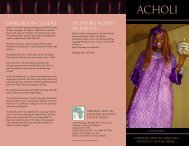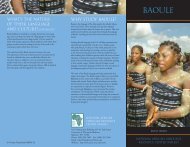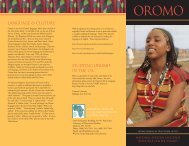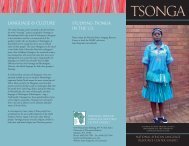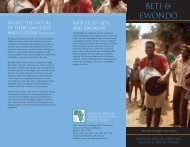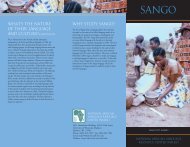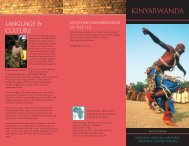mandinka - National African Language Resource Center
mandinka - National African Language Resource Center
mandinka - National African Language Resource Center
Create successful ePaper yourself
Turn your PDF publications into a flip-book with our unique Google optimized e-Paper software.
<strong>mandinka</strong><br />
What’s the nature<br />
of their language<br />
and culture(continued)<br />
Rites of passage are held to mark the beginning of adulthood<br />
for Mandinka children. Both male and female children between<br />
the ages of four and fourteen have their genitalia ritually cut in<br />
separate age sets. The practice is done in secluded bushes and<br />
lasts between three to four weeks. During this time the children<br />
learn about family responsibilities, behaviour expectations,<br />
cultural identity, gender role relationships and social solidarity.<br />
Most of the teaching happens through song, dance and<br />
drumming. The Mandinka worldview is populated with<br />
malevolent spirits and witchcraft beliefs. These spirits can only<br />
be controlled through the power of marabouts that are believed<br />
to know the protective formulas. For this reason, no important<br />
decision can be made without first consulting the marabouts<br />
who have been trained in the Qu’ran (or Koran). Although a<br />
few Mandinkas have converted to Christianity, the majority of<br />
them are opposed to teachings of the Bible. Hence Christian<br />
converts are viewed as traitors to Mandinka society, its heritage<br />
and ancestral beliefs.<br />
Why study<br />
Mandinka<br />
It is worth noting that a significant number of <strong>African</strong><br />
Americans in the United States are descendants of the<br />
Mandinka people. One of the most notable Mandinka<br />
figures is Kunta Kinte whose name was popularized in Alex<br />
Haley’s book, Roots, and the subsequent television series.<br />
Haley claimed that his descent was from Kunta Kinte. Mr<br />
T, the famous American television personality also claims<br />
that his distinctive hairstyle has been modeled after that of<br />
Mandinka warriors. Admittedly, many celebrities and other<br />
popular figures in West Africa and beyond have close links<br />
with Mandinka ancestry. These include Alhaji Kabbah,<br />
former President of Sierra Leone; Sekou Toure, former<br />
President of Guinea; Salif Keita, the musician from Mali;<br />
Abdul Keita, the football star from Cote d’Ivoire; Soulemane<br />
Diawara, the football star from Senegal, Sir Dawda Jawara,<br />
former President of Gambia; and Cheick Kongo, the martial<br />
artist from Burkina Faso. For <strong>African</strong> Americans in search<br />
of their <strong>African</strong> heritage, a study of Mandinka language and<br />
culture can be hard to resist. Like Alex Haley and Mr T,<br />
knowledge of Mandinka can be a powerful statement about<br />
one’s origins and identity.<br />
<strong>National</strong> <strong>African</strong><br />
<strong>Language</strong> <strong>Resource</strong><br />
<strong>Center</strong> (NALRC)<br />
4231 Humanities Building, 455 N. Park Street<br />
University of Wisconsin-Madison<br />
Madison, WI 53706<br />
Phone: (608) 265-7905 Fax: (608) 265-7904<br />
Email: nalrc@mhub.facstaff.wisc.edu<br />
Website: http://african.lss.wisc.edu/nalrc<br />
a gambian woman in traditional attire<br />
<strong>National</strong> <strong>African</strong> <strong>Language</strong><br />
<strong>Resource</strong> <strong>Center</strong> (NALRC)<br />
nalrc_b_Mandinka_Gambia_453.indd 1<br />
4/7/10 12:39 PM
Who are the<br />
Mandinka people<br />
The Mandinka, also known as the Mandingo or Malinke, are<br />
one of the largest and popular erthnic group in West Africa.<br />
They have an estimated population of over 11 million that<br />
spreads across the whole West <strong>African</strong> region. While the<br />
Mandinka people can be found in Guinea Bissau, Mali, Sierra<br />
Leone, Cote d’Ivoire, Senegal, Burkina Faso, Liberia, Niger,<br />
Mauritania and Chad, the majority of them live in Gambia.<br />
They are descendants of the Mali Empire that rose to power<br />
under the rule of the great king Sundiata Keita. They make<br />
up one of the largest ethno-linguistic groups called the Mande<br />
who number more than 20 million people including the<br />
Dyula, Bozo and Bambara.<br />
The Mandinka migrated westwards from the Niger river basin<br />
in search of better agricultural lands and opportunities for<br />
conquest. During this historical expansion, they established<br />
their empire in the area stretching from present day Gambia to<br />
Guinea. While the majority of Mandinkas were still animists<br />
up to the 18th century, over 99% converted to Islam through<br />
a series of conflicts with the Fula led kingdom of Fouta<br />
Djallon and the Mande led empire of Kaabu. This conversion<br />
began during the reign of the Mandinka ruler, Mansa Musa<br />
(AD 1320 – 1358). From the 16th to the 18th century, more<br />
than a third of the Mandinkas were shipped to the Americas as<br />
slaves through capture in conflicts.<br />
A considerable number of the Mandinka people have been<br />
located along long distance trade routes beginning from the<br />
time of the Mali Empire. Many are referred to as dyoula, a<br />
Mande word meaning ‘merchant’. Mandinka communities<br />
established their trading networks near mining and agricultural<br />
centres which later became the lynchpin for trade with<br />
European merchants from the 17th century. Much of the<br />
overland trade connecting the coast with the interior was<br />
controlled by the Mandinka merchants. The other part of<br />
Mandinka people are rural subsistence farmers. While the<br />
women work in the rice fields, the men engage in peanut<br />
production as the main cash crop.<br />
What’s the nature<br />
of their language<br />
and culture<br />
Mandinka belongs to the Mande cluster of languages that<br />
makes up the largest ethno-linguistic group in West Africa.<br />
They possess a very rich cultural heritage that has been passed<br />
on from generation to generation. The typical Mandinka family<br />
lives in village compounds headed by a chief and a group of<br />
elders. Most of their education is done through stories, songs<br />
and proverbs conveyed by praise singers or griots. Perhaps the<br />
most distinctive trait of the Mandinka is their popular music<br />
which is played on a unique musical instrument called the kora.<br />
The kora has emerged as the hallmark of traditional Mandinka<br />
musicians. Its is a 21 string harp-like instrument made of a<br />
large calabash or gourd covered with cow skin. There is a belief<br />
that as the kora is played, it takes on a life of its own to a point<br />
where the singer and the instrument become one. Traditionally,<br />
the kora was regarded as the storage for historical facts, the<br />
memory of people’s genealogy, the singer of their praises, the<br />
intermediary of family disputes, the guardian of culture and the<br />
source of entertainment. However, the kora is gradually losing<br />
its importance as it has primarily become a symbol of cultural<br />
tourism.<br />
Historically, Mandinka marriages were arranged by family<br />
members rather than the bride and groom. The suitor’s<br />
family would formally send kola nuts to the male elders of the<br />
prospective bride. The acceptance of the kola nut marked the<br />
beginning of courtship. Mandinka men are allowed to have<br />
up to four wives as long as they can take care of them. The<br />
crowning glory of every Mandinka woman is believed to be<br />
the ability to produce children, especially sons. Men have total<br />
authority over their wives and are responsible for feeding and<br />
clothing them.<br />
Rice harvesters<br />
A Mandinkan woman<br />
carrying a child<br />
A Gambian street known as<br />
Marina Parade<br />
A Gambian woman<br />
nalrc_b_Mandinka_Gambia_453.indd 2<br />
4/7/10 12:39 PM


